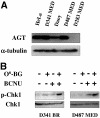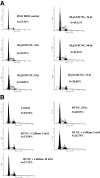Bifunctional DNA alkylator 1,3-bis(2-chloroethyl)-1-nitrosourea activates the ATR-Chk1 pathway independently of the mismatch repair pathway - PubMed (original) (raw)
Bifunctional DNA alkylator 1,3-bis(2-chloroethyl)-1-nitrosourea activates the ATR-Chk1 pathway independently of the mismatch repair pathway
B Cui et al. Mol Pharmacol. 2009 Jun.
Abstract
The presence of DNA damage initiates signaling through the ataxia-telangiectasia mutated kinase (ATM) and the ATM- and the Rad3-related kinase (ATR), which phosphorylate, thus activating, the checkpoint kinases (Chk) 1 and 2, which leads to cell cycle arrest. The bifunctional DNA alkylator 1,3-bis(2-chloroethyl)-1-nitrosourea (BCNU) is cytotoxic primarily by inducing DNA monoadducts and ultimately, interstrand cross-links, which block DNA replication. In this study, we investigated the activation of the ATR-Chk1 pathway in response to BCNU treatment and the dependence of this response on the DNA mismatch repair (MMR) capacity. Medulloblastoma cells were exposed to low and moderate doses of BCNU, and the effects on this DNA damage signaling pathway were examined. In response to BCNU, Chk1 was found to be phosphorylated at serine 345 and exhibited increased kinase activity. Caffeine and wortmannin, which are broad-spectrum inhibitors of ATM and ATR, reduced this phosphorylation. Cell cycle analysis further revealed an accumulation of cells in the S phase in response to BCNU, an effect that was attenuated by caffeine. Small interfering RNA knockdown of ATR also reduced Chk1 phosphorylation after exposure to BCNU. However, knockdown of ATM had no effect on the observed Chk1 phosphorylation, suggesting that ATR was primarily responsible for Chk1 activation. Analysis of Chk1 activation in cells deficient in MMR proteins MutLalpha or MutSalpha indicated that the DNA damage response induced by BCNU was independent of the MMR apparatus. This MMR-independent activation seems to be the result of DNA interstrand cross-link formation.
Figures
Fig. 1.
BCNU induces phosphorylation of Chk1. A, toxicity of low doses of BCNU to D341 MED cells was determined by limiting dilution assay. Each data point represents the average of three independent experiments; bars, ± S.D. B to D, Chk1 is phosphorylated at serine 345 after DNA damage by BCNU. D341 MED cells were exposed to 0.2 to 20 μM BCNU for 16 h (B) or 20 μM BCNU for the indicated periods (C). D, Daoy, D487 MED, or D283 MED cells were exposed to 0.2 to 20 μM BCNU for 16 h. Cell lysates were immunoblotted with anti-phospho-Chk1 antibody (serine 345) (p-Chk1) and anti-Chk1 antibody.
Fig. 2.
_O_6-BG potentiates the phosphorylation of Chk1. A, AGT expression in D341 MED, Daoy, and D487 MED. Cell lysates were immunoblotted with anti-AGT antibody, HeLa cell lysates were used as positive control for AGT and α-tubulin was used as a loading control. B, cotreatment with BCNU and _O_6-BG increases Chk1 phosphorylation. D341 MED (BR) and D487 MED were treated with 20 μM BCNU alone or in combination with 10 μM _O_6-BG. Cell lysates were immunoblotted with anti-phospho-Chk1 antibody (serine 345) and anti-Chk1 antibody.
Fig. 3.
ATR is involved in the activation of Chk1. D341 MED was treated with 20 μM BCNU alone or in combination with 10 mM caffeine (A) or 30 μM wortmannin (B), and cell lysates were prepared 6 h after treatment and immunoblotted with anti-phospho-Chk1 antibody (serine 345) and anti-Chk1 antibody. D341 MED cells (C) or Daoy cells (D) were transfected with siRNA against ATR, ATM, or a scrambled RNA sequence (scrRNA) and treated with 20 μM BCNU for 4 to 6 h at approximately 48 to 72 h after transfection. The cell lysates were immunoblotted with anti-ATR antibody, anti-ATM antibody, anti-phospho-Chk1 antibody (serine 345), and anti-Chk1 antibody.
Fig. 4.
BCNU-induced activation of Chk1 is independent of MMR proteins. Cell lysates from HeLa, D341 MED, Daoy, D487 MED, and D283 MED (A) or from TE-671 and TE-671 (OTR) (C) were immunoblotted with anti-MSH2, MSH6, MLH1, and PMS2 antibodies. α-Tubulin was used as a marker for loading control, and HeLa cell lysates were used as the positive control for the MMR proteins. D283 MED and Daoy cells (B) or TE-671 and TE-671 (OTR) (D) were treated with 20 μM BCNU or temozolomide (TMZ), and cell lysates were immunoblotted with anti-phospho-Chk1 antibody (serine 345) and anti-Chk1 antibody. E, Daoy cells were transfected with siRNA against MLH1 or scrambled RNA. The cell lysates were immunoblotted with anti-MLH1 and α-tubulin antibodies. α-tubulin was used as a marker for loading control. F, Daoy cells were transfected as in E. Transfected and untransfected cells were treated with 20 μM BCNU or temozolomide. The cell lysates were immunoblotted with antibodies against phospho-Chk1 (serine 345), Chk1, MLH1, and α-tubulin. α-tubulin was used as a marker for loading control.
Fig. 5.
Cell cycle perturbations caused by BCNU. A, D341 MED cells were treated with 20 μM BCNU for 1 h, and the cells were harvested and processed for flow cytometric analysis of DNA content at the indicated time points. The cell cycle profiles shown were representative of at least three independent experiments. B, D341 MED cells were treated with 20 μM BCNU alone or in combination with 3, 5, or 10 mM caffeine and processed for flow cytometry 24 h after treatment. The cell cycle profiles shown are representative of at least three independent experiments. Solid areas, G1 phase or G2/M phase; diagonal lines, S phase.
Similar articles
- CHK1 and CHK2 are differentially involved in mismatch repair-mediated 6-thioguanine-induced cell cycle checkpoint responses.
Yan T, Desai AB, Jacobberger JW, Sramkoski RM, Loh T, Kinsella TJ. Yan T, et al. Mol Cancer Ther. 2004 Sep;3(9):1147-57. Mol Cancer Ther. 2004. PMID: 15367709 - Interactions of human mismatch repair proteins MutSalpha and MutLalpha with proteins of the ATR-Chk1 pathway.
Liu Y, Fang Y, Shao H, Lindsey-Boltz L, Sancar A, Modrich P. Liu Y, et al. J Biol Chem. 2010 Feb 19;285(8):5974-82. doi: 10.1074/jbc.M109.076109. Epub 2009 Dec 22. J Biol Chem. 2010. PMID: 20029092 Free PMC article. - Ataxia-telangiectasia-mutated (ATM) and NBS1-dependent phosphorylation of Chk1 on Ser-317 in response to ionizing radiation.
Gatei M, Sloper K, Sorensen C, Syljuäsen R, Falck J, Hobson K, Savage K, Lukas J, Zhou BB, Bartek J, Khanna KK. Gatei M, et al. J Biol Chem. 2003 Apr 25;278(17):14806-11. doi: 10.1074/jbc.M210862200. Epub 2003 Feb 14. J Biol Chem. 2003. PMID: 12588868 - The ATM-Chk2 and ATR-Chk1 pathways in DNA damage signaling and cancer.
Smith J, Tho LM, Xu N, Gillespie DA. Smith J, et al. Adv Cancer Res. 2010;108:73-112. doi: 10.1016/B978-0-12-380888-2.00003-0. Adv Cancer Res. 2010. PMID: 21034966 Review. - Novel regulation of checkpoint kinase 1: Is checkpoint kinase 1 a good candidate for anti-cancer therapy?
Goto H, Izawa I, Li P, Inagaki M. Goto H, et al. Cancer Sci. 2012 Jul;103(7):1195-200. doi: 10.1111/j.1349-7006.2012.02280.x. Epub 2012 Apr 23. Cancer Sci. 2012. PMID: 22435685 Free PMC article. Review.
Cited by
- Mismatch repair proteins play a role in ATR activation upon temozolomide treatment in MGMT-methylated glioblastoma.
Ganesa S, Sule A, Sundaram RK, Bindra RS. Ganesa S, et al. Sci Rep. 2022 Apr 6;12(1):5827. doi: 10.1038/s41598-022-09614-x. Sci Rep. 2022. PMID: 35388070 Free PMC article. - Mechanisms of DNA damage, repair, and mutagenesis.
Chatterjee N, Walker GC. Chatterjee N, et al. Environ Mol Mutagen. 2017 Jun;58(5):235-263. doi: 10.1002/em.22087. Epub 2017 May 9. Environ Mol Mutagen. 2017. PMID: 28485537 Free PMC article. Review. - Advances in understanding the complex mechanisms of DNA interstrand cross-link repair.
Clauson C, Schärer OD, Niedernhofer L. Clauson C, et al. Cold Spring Harb Perspect Biol. 2013 Oct 1;5(10):a012732. doi: 10.1101/cshperspect.a012732. Cold Spring Harb Perspect Biol. 2013. PMID: 24086043 Free PMC article. Review. - Effective elimination of cancer stem cells by a novel drug combination strategy.
Yuan S, Wang F, Chen G, Zhang H, Feng L, Wang L, Colman H, Keating MJ, Li X, Xu RH, Wang J, Huang P. Yuan S, et al. Stem Cells. 2013 Jan;31(1):23-34. doi: 10.1002/stem.1273. Stem Cells. 2013. PMID: 23132831 Free PMC article.
References
- Abraham RT (2004) PI 3-kinase related kinases: `big' players in stress-induced signaling pathways. DNA Repair (Amst) 3 883-887. - PubMed
- Aida T and Bodell WJ (1987) Effect of caffeine on cytotoxicity and sister chromatid exchange induction in sensitive and resistant rat brain tumor cells treated with 1,3-bis(2-chloroethyl)-1-nitrosourea. Cancer Res 47 5052-5058. - PubMed
- Aquilina G, Crescenzi M, and Bignami M (1999) Mismatch repair, G2/M cell cycle arrest and lethality after DNA damage. Carcinogenesis 20 2317-2326. - PubMed
Publication types
MeSH terms
Substances
LinkOut - more resources
Full Text Sources
Molecular Biology Databases
Research Materials
Miscellaneous




